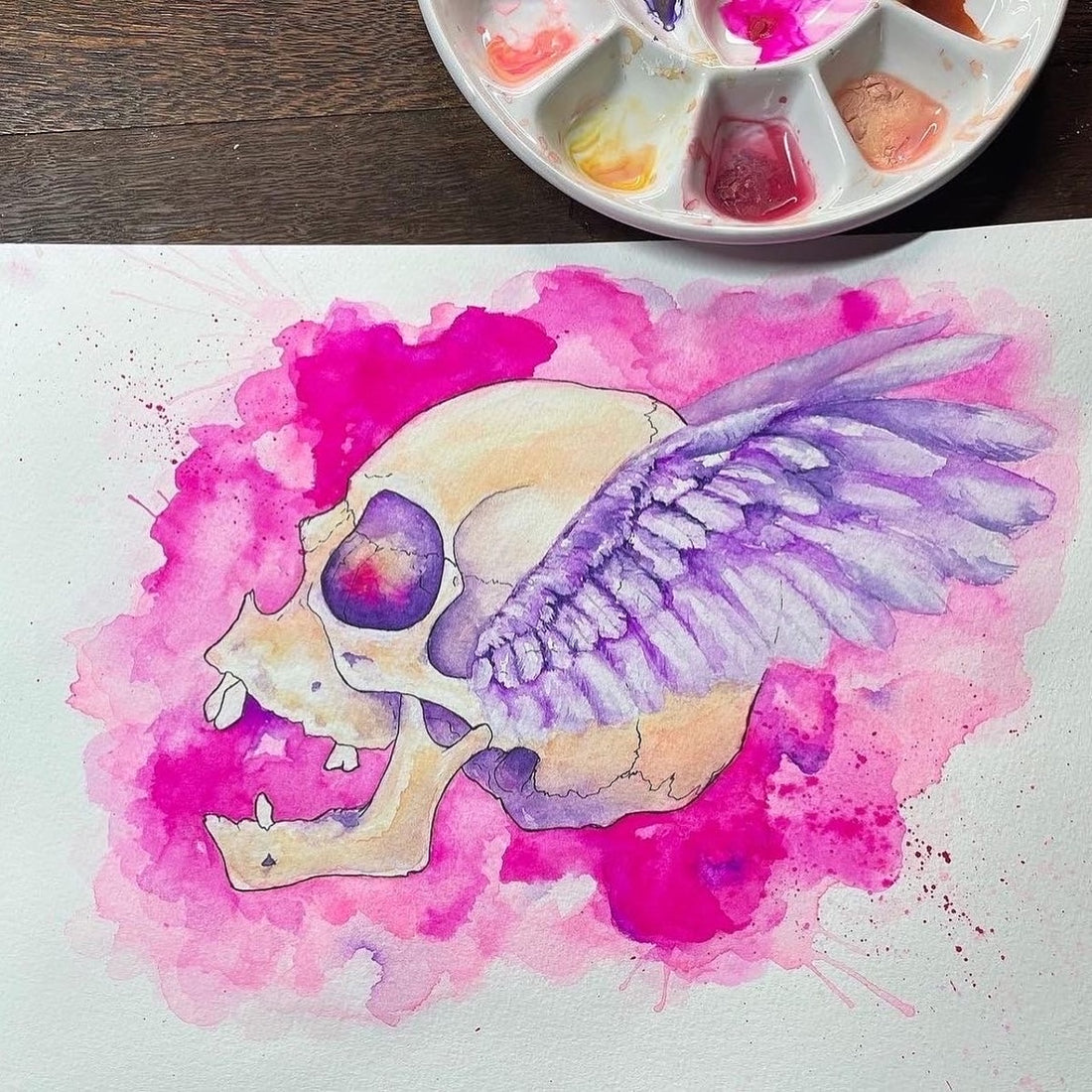
A Journey Through Watercolor Art with J. Brooke Wade
Share
Step Into the Luminous World of Watercolors
Watercolor painting transcends being merely an art form; it is a subtle interplay of water and pigment, culminating in an ethereal, translucent beauty. I, J. Brooke Wade, your guide and fellow watercolor artist, am thrilled to unveil the unique allure and meticulous technique of watercolor art. The hallmark of watercolors—transparency—allows for a luminosity and depth unattainable with other painting methods. This journey through the world of watercolors will enrich your understanding and inspire your creative endeavors.
The Transparent Heart of Watercolors
The transparency of watercolors provides a capacity for layering that brings about rich, nuanced color variations which distinguish this medium. Watercolors' delicate nature permits light to seep through each stroke and bounce back from the paper, infusing the artwork with unmatched vibrancy and vitality. This inherent quality makes watercolor painting a continuous exploration of light and color, transforming even the simplest compositions into dynamic visual experiences.
Layering Techniques
Layering in watercolor painting is both an art and a science. Each new layer of paint interacts with the previous ones, creating depth and complexity. This technique requires patience and precision, as the timing of each layer's application can significantly affect the final outcome. Understanding the drying times and how different pigments interact when layered is crucial for achieving the desired effects.
Achieving Vibrancy
To achieve the vibrant hues that watercolor is known for, artists often work with high-quality pigments and paper. The type of paper used can dramatically influence the vibrancy of the colors. Cold-pressed paper, with its slight texture, can hold more pigment, resulting in brighter colors, while hot-pressed paper provides a smooth surface for more delicate washes and detailed work.
Crafting Watercolor Paints
Delving into how watercolor paints are made can enrich appreciation for this form. This artistry begins with blending finely milled pigments with a binder like gum arabic, followed by water. The pigment's granularity, along with the binder quantity, greatly influences the transparency and texture of the paint, illustrating why the process of how watercolor paints are made is as intricate as the art of using them.
The Role of Pigments
Pigments are the heart of watercolor paints. Their origin—be it mineral, synthetic, or organic—affects the paint's hue, granulation, and lightfastness. For instance, earth pigments like ochre and sienna offer warm, natural tones, while synthetic pigments provide vibrant, modern colors. Understanding these differences helps artists choose the right pigments for their desired effects.
Gum Arabic: The Essential Binder
Gum arabic, derived from the sap of the acacia tree, is the traditional binder used in watercolor paints. It dissolves easily in water, creating a smooth consistency that allows pigments to flow effortlessly. This binder also enhances the luminosity of the paint, making colors appear more vibrant and allowing for subtle gradations in tone.
The Fluid Dance of Water and Color
As a watercolor artist, I cherish the spontaneity with which water spreads the pigment across the canvas. This approach demands a perfect balance of control and surrender, permitting the water to orchestrate unexpected blends and gradients. This element of surprise makes each creation uniquely enthralling and presents a delightful challenge.
Embracing Spontaneity
Watercolor painting is often described as a dance between the artist and the medium. This dance involves a constant give-and-take, where the artist must respond to the unpredictable nature of water. Embracing this spontaneity allows for the creation of organic shapes and fluid transitions that are impossible to achieve with other mediums.
Techniques for Control
While spontaneity is a key aspect of watercolor painting, there are techniques to exert more control over the medium. Using masking fluid, for instance, can preserve white areas of the paper, creating sharp contrasts. Lifting techniques, where wet brushes or sponges are used to remove pigment, can lighten areas and add texture.
A Peek into Watercolor History
When was watercolor invented? Its origins are ancient, going back to times when it was used in manuscript illumination. Watercolor emerged as a standalone medium during the Renaissance. Reflecting on when watercolor was invented enhances our understanding of its profound impact on art history and cultural storytelling.
Ancient Beginnings
Watercolors were first used by ancient Egyptians for decorating papyrus scrolls. These early works primarily used natural pigments and were often employed for ceremonial or religious purposes. This historical context highlights the long-standing relationship between watercolor painting and the human desire to capture the beauty of the natural world.
Renaissance Revival
During the Renaissance, artists began to explore watercolor as a medium for fine art. Albrecht Dürer, a master of the Northern Renaissance, is celebrated for his detailed watercolor landscapes and botanical studies. His work demonstrated the potential of watercolor for capturing the subtleties of light and texture, paving the way for future generations of artists.
Unique Techniques for Distinctive Creations
Techniques like wet-on-wet—applying water before pigment dries—and dry brush, for adding textured, vibrant details, set watercolor painting apart. These practices underscore the fluidity and expressive capability of watercolors, enabling artists like myself to explore effects that are elusive in other mediums.
Wet-on-Wet Technique
The wet-on-wet technique involves applying wet paint onto a wet surface. This approach allows colors to blend and flow into one another, creating soft edges and gradual transitions. It's particularly effective for painting skies, water, and other elements where smooth, continuous gradations are desired.
Dry Brush Technique
In contrast, the dry brush technique involves using a relatively dry brush loaded with paint on a dry surface. This method creates sharp, textured lines and is ideal for adding details or creating rough textures. It's a versatile technique that can add depth and contrast to a painting, making it more dynamic.
Embark on a Journey of Discovery
The interplay of simplicity and complexity in watercolors provides a broad canvas for artists of all skill levels. I invite you to dive into this stunning medium, whether you are wielding a brush for the first time or honing your craft. Learning about the properties of the paints and experimenting with various techniques can revolutionize your watercolor approach and results.
Starting Your Watercolor Journey
For beginners, the key is to start simple. Begin with basic supplies—high-quality paper, a set of primary colors, and a few brushes. Practice fundamental techniques like washes, gradients, and simple compositions. As you gain confidence, you can experiment with more complex techniques and expand your palette.
Advanced Exploration
For more experienced artists, the journey with watercolors is one of continual learning and experimentation. Try integrating mixed media into your watercolor work, such as ink, pencil, or collage. Explore different styles, from hyper-realistic to abstract, and challenge yourself with new subjects and compositions.
Join the Watercolor Community
Let's continue to expand the possibilities of what can be achieved with watercolors. Join me in venturing into the bright, vivid expanse of this magnificent medium and uncover the distinct charm exclusive to watercolor art. Whether a novice or an experienced painter, the world of watercolors beckons with infinite possibilities for creativity and expression.
Sharing and Learning Together
One of the joys of being a watercolor artist is the sense of community. Sharing your work, learning from others, and participating in group projects or challenges can be incredibly rewarding. Online forums, social media groups, and local art clubs provide great opportunities to connect with fellow watercolor enthusiasts.
Continuous Improvement
As with any art form, continuous practice and a willingness to experiment are key to improvement. Keep a sketchbook to document your progress, ideas, and experiments. Attend workshops and classes to learn new techniques and gain fresh perspectives. Most importantly, enjoy the process and let your passion for watercolor guide your creative journey.
Watercolor painting is a journey filled with exploration, discovery, and endless possibilities. With each brushstroke, you have the chance to create something truly unique and beautiful. I invite you to embrace the fluidity, the light, and the vibrant colors of watercolors, and to find joy in the art of painting. Together, we can explore the luminous world of watercolors and continue to push the boundaries of what can be achieved with this remarkable medium.
